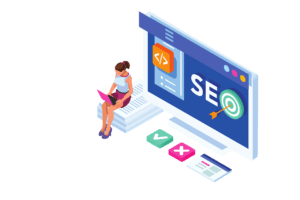Reasons for website redesign.
A website is essential to any business, providing a platform to showcase products, services, and company information. However, just like any other aspect of a business, websites require regular updates and maintenance to remain effective. And this is where reasons for website redesign comes into play.
Web redesign is revamping a website to improve its performance, usability, and overall user experience.
An effective website is crucial in today’s digital age, where most consumers search for information online. A website is the first point of contact between a business and customers; therefore, a positive first impression is required.
An effective website can improve customer engagement, increase sales, and help businesses to achieve their goals.
There are several reasons for a website redesign. Some reasons include outdated design, poor user experience, branding or business goals changes, and technological advances. In this article, we will focus on these reasons for web redesign and how it can negatively impact a website’s effectiveness.
1. Outdated Design
An outdated design can harm a website’s effectiveness by making it look old-fashioned, unprofessional, and difficult to use. Gaining user trust and engagement can be challenging when a website looks outdated.
Visitors may question the credibility of the website and assume that the business is no longer active or not invested in keeping up with current trends. This can lead to decreased traffic, reduced engagement, and revenue loss.
Examples of outdated design elements and trends include cluttered layouts, small fonts, excessive use of flash, busy backgrounds, and low-quality images. These design elements were popular in the past but are no longer effective in today’s digital era.
For example, small fonts may have been acceptable in the past when most users accessed the internet via desktop computers. However, with the rise of mobile devices, small fonts can make a website difficult to read and navigate on smaller screens.
2. Poor User Experience
A website’s user experience (UX) is vital to its effectiveness. User experience refers to a visitor’s overall experience while interacting with a website, e.g., ease of navigation, readability of content, and overall satisfaction.
Poor user experience can lead to high bounce rates, low engagement, and loss of potential customers.
Some common bad user experiences on a website include:
- Slow page loading times.
- Confusing navigation menus.
- Small or difficult-to-read fonts.
- Lack of mobile optimization.
Visitors expect a website to be easy to navigate, fast-loading, and visually appealing. They will likely leave the website and look for alternatives if these expectations are unmet.
It’s important to simplify the navigation structure and make it easier for visitors to find the information they are searching for. This can be achieved by clearly labeling and organizing menus and submenus, adding a search bar, etc.
The website’s layout and design should also be optimized for readability, with clear headings and subheadings, plenty of white space, and fonts that are easy to read.
3. Incompatibility with Modern Technology
As technology evolves, a website’s compatibility with modern technology becomes increasingly important.
Incompatibility with modern technology can result in a website that is slow to load, difficult to navigate, and potentially unusable on certain devices or web browsers. This can lead to frustrated visitors and loss of business opportunities.
Keeping up with the latest web technology and design developments is important; this includes using modern programming languages and frameworks.
Web browser compatibility is also critical, as visitors may be using a variety of web browsers to access the website. Ensuring compatibility with different web browsers can involve testing the website on different browsers and addressing any compatibility issues.
Poor user experience and incompatibility with modern technology are reasons for a website redesign for greater success for the business.
4. Search Engine Optimization (SEO) Issues
Another reasons for a website redesign is SEO issues. Search engine optimization (SEO) improves a website’s online visibility in search engine results. SEO is crucial for driving organic traffic to a website and can significantly impact a website’s success.
Common SEO issues on a website include poor content quality, lack of keyword research, and slow page loading times.
Poor content quality can negatively impact a website’s SEO by reducing its relevance and authority in search engines.
Slow page loading times can also negatively impact a website’s SEO.
Visitors expect websites to load quickly, and slow-loading websites can lead to high bounce rates and reduced engagement.
A website redesign can improve a website’s visibility and drive more traffic. A website optimized for search engines helps to rank higher in search engine results, leading to increased visibility and more customers.

5. Branding Changes
A change in a business’s branding can significantly impact its website. A new brand identity may require a complete website redesign to reflect the new branding, including changes to the website’s color scheme, logo, and overall design aesthetic.
In addition, changes to the business’s products, services, or target audience may also necessitate a website redesign to ensure that the website effectively communicates the new messaging.
Updating a website to reflect a new brand identity involves more than simply changing the logo and color scheme. It’s important to consider the overall messaging and tone of the website, ensuring that it accurately reflects the business’s new brand identity.
6. Security Concerns
Website security is essential to protect both the website owner and users. A lack of website security can lead to data breaches, loss of user information, and even website downtime.
Common website security concerns include malware infections, hacking attempts, and phishing attacks.
- Malware infections occur when a website is infected with malicious software, which can damage the website and steal user information.
- Hacking attempts involve unauthorized access to the website, which can result in data breaches or defacement.
- Phishing attacks involve fraudulent attempts to obtain sensitive, such as passwords or credit card details, by posing as a legitimate entity.

To eliminate these security issues, you must redesign your website to remove loopholes.
7. Site Speed
Site speed is another crucial factor that can impact website performance. Slow-loading sites can lead to high bounce rates, reduced engagement, and lower search engine rankings.
Websites that are slow to load can result in a negative user experience, which affects website traffic and revenue.
Common site speed issues include large images, excessive use of plugins & scripts, and inadequate hosting.
Excessive use of plugins and scripts can also slow down page loading times, so it’s important to redesign the website to eliminate scripts or software that slow the website.
8. Expansion into new markets or geographic regions
A new market can be a great opportunity for a business to grow, but it may also require a different approach to the website.
When entering a new market, it’s important to understand the target audience’s local culture, preferences, and behaviors. This understanding should be reflected in the website’s design, content, and functionality.
For example, if a business is expanding into a market with a different language, the website may need to be translated and localized to appeal to the local audience.
The layout and design of the website may also need to be adapted to fit the cultural norms and preferences of the new market. Different cultures have different choices for design, layout, and content.
For example, colors considered lucky in one culture may be associated with negativity in another.
Additionally, the new market may have different regulations and requirements that the website needs to comply with. This could include data privacy laws, payment processing regulations, and accessibility guidelines.
A website redesign can ensure that the website meets these requirements and is fully optimized for the new market.
9. Inadequate Analytics or Tracking
Analytics and tracking are crucial for measuring the effectiveness of a website. They provide valuable insights into user behavior, such as how users navigate the site, what pages they visit, and how long they stay on each page.
These details can be used to optimize the site, improve user experience, and increase conversion rates.
However, many websites still rely on outdated tracking methods such as server logs or basic page counters. These methods provide limited data and do not provide insights into user behavior.
How to Create an Online store 2023: A Step-by-Step Guide
5 Step On How to start an online store
You need advanced website tracking tools to get a comprehensive picture of how users interact with your website.
Ensure you use the latest tracking tools and that your website is properly configured to collect and analyze data. This will give you the insights you need to improve your website and grow your business.
10. Device Optimization
With the rise of mobile devices, ensuring your website is optimized for all devices, i.e., desktops, tablets, and smartphones, is essential.
Optimize for different devices to avoid a poor user experience, high bounce rates, and lost opportunities.
Optimizing a website for different devices involves more than resizing images and text. It also includes optimizing page load times, ensuring that navigation is easy to use on small screens, and providing touch-friendly controls. Device optimization is more important than ever.
Common optimization issues on a website include slow page load times, poor mobile navigation, and unresponsive design.
To ensure your website is optimized for all devices, you should use a responsive design that adjusts to different screen sizes and resolutions. You should also optimize images and content for faster loading times and test your website on various devices to ensure it works correctly.
In conclusion, there are several reasons why a website need to be redesigned. A website redesign help address the above issues and ensure the website is optimized for success.
By updating the design, improving user experience, ensuring compatibility with modern technology, enhancing website security, improving site speed, and implementing proper tracking and analytics, a website can be transformed into a more effective tool for a business.
A website redesign is an important investment for a business that wants to stay competitive in today’s digital age. It can help improve the user experience, increase online visibility, and drive more conversions, leading to business growth and success.
Don’t wait any longer to upgrade your website. Contact us today to learn more about our services and how we can help take your online presence to the next level.
